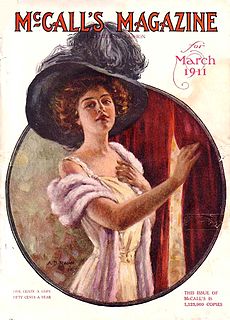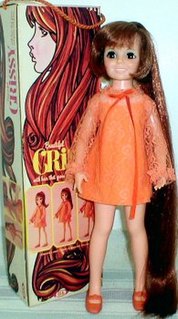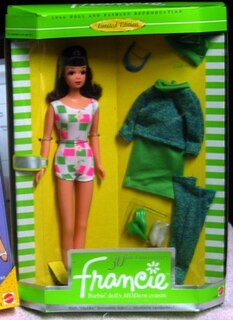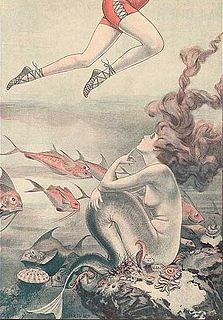
Action Man is an action figure launched in Britain in 1966 by Palitoy as a licensed copy of Hasbro's American "movable fighting man", G.I. Joe.
Denise Holly Hobbie is an American writer, watercolorist and illustrator. Holly Hobbie is also the name of a fictional character that she created.

McCall's was a monthly American women's magazine, published by the McCall Corporation, that enjoyed great popularity through much of the 20th century, peaking at a readership of 8.4 million in the early 1960s. It was established as a small-format magazine called The Queen in 1873. In 1897 it was renamed McCall's Magazine—The Queen of Fashion and subsequently grew in size to become a large-format glossy. It was one of the "Seven Sisters" group of women's service magazines.
Chatty Cathy is a pull string "talking" doll originally created by Ruth and Elliot Handler and manufactured by the Mattel toy company from 1959 to 1965. The doll was first released in stores and appeared in television commercials beginning in 1960, with a suggested retail price of $18.00, but catalog advertisements usually priced the doll under $10.00. Chatty Cathy was on the market for six years and was the second most popular doll of the 1960s after Barbie.

Crissy is an American fashion doll with a feature to adjust the length of its hair. Crissy was created in the Ideal Toy Corporation's prototype department in 1968. She has auburn hair and is 18 inch (36 cm) tall. While having stationary foundation or base hair rooted to its head, the Crissy doll also had another thick strand or lock of hair that emerged from an opening in the top of the doll's head, which could be lengthened or shortened with a knob in the doll's back so a child could choose to make the hair short or long.

What's Her Face was a line of customizable dolls that straddled the line between traditional fashion dolls and creative activity toys. Made by Mattel, the line ran from 2001–2003, and enjoyed only a modest success in a market dominated by Mattel's iconic Barbie and MGA Entertainment's Bratz dolls. Following the discontinuation of the What's Her Face line, their body molds were used for the Wee 3 Friends line of Barbie-related dolls. Several fashion, wig, and activity packs were also released for the What's Her Face line.
The Bild Lilli doll was a German fashion doll launched on August 12, 1955 and produced until 1964. Its design was based on the comic-strip character Lilli, created by Reinhard Beuthien for the German tabloid newspaper Bild. The doll was made of polystyrene, came in two sizes, and had an available wardrobe of 1950s fashion. The Lilli doll was copied, and altered to some degree, for Mattel upon the direction of that company's co-founder, Ruth Handler. Mattel acquired the rights to Bild Lilli in 1964, and production of the German doll ceased, in favor of Mattel's new vinyl doll which they called Barbie.

Sindy is a British fashion doll created by Pedigree Dolls & Toys in 1963. A rival to Barbie, Sindy's wholesome look and range of fashions and accessories made her the best-selling toy in the United Kingdom in 1968 and 1970. After Marx Toys' unsuccessful attempt to introduce Sindy in the United States in the late 1970s, Hasbro bought the rights to Sindy and remodelled the doll to look more American. As a result, the doll's popularity declined; in addition Barbie manufacturer Mattel filed a lawsuit for copyright infringement, which was settled when Hasbro agreed to remodel Sindy's face. During the 1990s, Barbie's share of the doll market continued to grow while Sindy's diminished, which led to Sindy being delisted from major retailers in 1997. Hasbro returned the doll's licence to Pedigree, and the doll was relaunched in 1999, manufactured by Vivid Imaginations. Sindy's 40th anniversary in 2003 saw a new manufacturer, New Moons, and another relaunch and redesign.

Francie Fairchild is a fashion doll issued by Mattel from 1966 to 1976 and re-introduced in 2011. Marketed as "Barbie's MODern cousin" from England, the doll had an extensive line of "mod"-style clothing, often employing bright colors and geometric patterns similar to fashions associated with Carnaby Street in the late 1960s to early 1970s. At 11¼ inches tall, the Francie doll was shorter than Barbie, but taller than Skipper, making the character presumably between the two in age.

My Child dolls are a toy made by Mattel from 1985-1988. Most had felt "skin" on their heads although some had vinyl skin.
Tressy was an American fashion doll with a feature to adjust the length of its hair. Tressy was first produced by American Character Doll Company in the 1960s and later by Ideal Toy Company in the 1970s. The doll was invented and patented by modern furniture designer Jesse Dean and his wife, Diana.

Bécassine is a French comic strip and the name of its heroine, appearing for the first time in the first issue of La Semaine de Suzette on February 2, 1905. She is considered one of the first female protagonists in the history of French comics.

Chéri Hérouard (1881–1961) was a French illustrator who was most famously known for his forty-five-year work for French society magazine, La Vie Parisienne. Born as Chéri-Louis-Marie-Aime Haumé in Rocroi on 6 January 1881, Hérouard's father died in a hunting accident just before his birth. His mother remarried to a Hérouard, who was a descendant of the doctor of Louis XIII, and Chéri took the new name. Hérouard married Henriette Tabillon on 17 August 1903. Chéri Herouard's first printed artwork appeared in Le Journal de la Jeunesse in 1902. Upon stepping into the Publishing House of Calmann-Lévy, he met Anatole France, who encouraged him to continue his work.
Daisy was a 1970s doll designed by British fashion designer Mary Quant.

A Dolly Varden, in this sense, is a woman's outfit fashionable from about 1869 to 1875 in Britain and the United States. It is named after a character in Charles Dickens, and the items of clothing referred to are usually a hat or dress.
Gautier-Languereau is a French publishing house, founded by Maurice Languereau and Henri Gautier, and currently owned by Hachette Livre, and used as an imprint for children's literature.
La Semaine de Suzette was a French magazine aimed at girls, which appeared from 1905 until 1960. It contained early comics like Bécassine.
Mdvanii was originally conceived as a conceptual art and fashion doll for adults by artist BillyBoy*. Since 1990 it has been a collaboration with his life partner, artist Jean Pierre Lestrade. The 25 cm (9.8 in) tall doll was originally made in a matte Caron make-up toned hard resin. Mdvanii debuted on February 14, 1989 in London, England.
Jacqueline Rivière (1851-1920) was a pseudonym of a French writer, newspaper editor-in-chief and creator of the successful comic strip Bécassine.

Jacques Abeillé, known as Jack Abeillé, was a French painter, poster designer, draughtsman, and illustrator.











